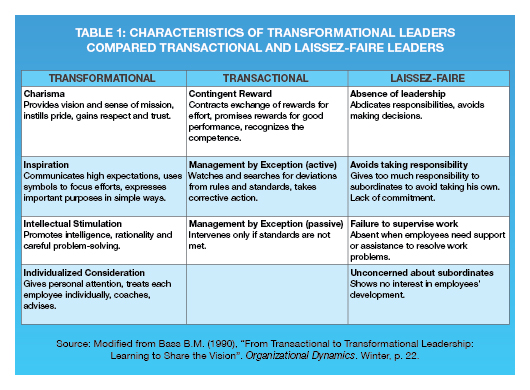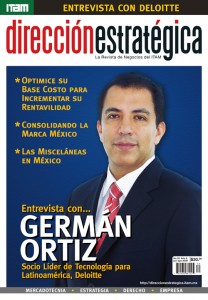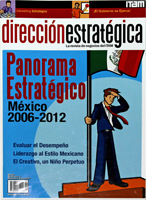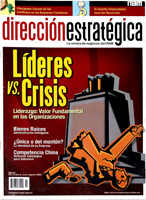
By: Doctor Gloria
In 1984, Noel Tichy and David Ulrich declared that to revitalize the US economy, the national agenda would have to include the creation of a new style of leadership: one that would no longer lead companies by the traditional paths, but which could transform them so that they could reinvent themselves. This new style was called transformational leadership.
Tichy and Ulrich’s statement 25 years ago is today highly relevant to today’s Mexico. Many of our political, social and business institutions need to be renewed by transformational leaders who can propose a new vision and are able to mobilize all the participants. Only if we reinvent our organizations can we make our economy grow and pull our country out of the rut into which it seems to be catch in a loop..
This article analyzes the characteristics of transformational leadership, its differences with other styles of leadership and its relationship with emotional intelligence, so readers can discover the abilities and skills they need to strengthen in order to bring about change in their organizations.
1. Transformational Leadership
Although Burns was already using the term “transformational leadership” in 1978 to describe certain political leaders, it was not until the 1980s that this new concept began to be studied in the business world. Scholars of organizational behavior were undoubtedly inspired by great directors like Jack Welch or Lee Iacocca, who brought about dramatic changes at General Electric and Chrysler, respectively. Thus, transformational leadership covers primarily organizational changes that are attributed to leadership.
The previous theories of leadership, like Hersey and Blanchard’s “situational leadership,” merely described how a leader should behave in order for others to do what they were asked, and explained how to cultivate the relationship with subordinates, or were focused on meeting goals. In contrast, transformational leaders are concerned more about the changes produced in their followers. Subordinates feel trust, admiration, loyalty and respect for their leader; they are so highly motivated that they exceed what is expected of them. Transformational leaders exercise a profound positive influence on the efforts of their subordinates and in the satisfaction they derive from their work. They are also able to convince their people to not be limited by their own personal interests, but to seek out the good of their team or their organization. To this end, leaders stimulate a higher order of needs and motivations in their employees, for growth, excellence and transcendence.
One influential study on detecting the characteristics of the transformational leader was presented by Bass 1990, in which he identified four basic dimensions of this style of leadership:
Charisma or Idealized Influence
- Provides a vision and a sense of mission
- Inculcates pride, generates respect and trust
Inspiration
- Acts as a model for subordinates
- Inspires vision and uses symbols for focusing efforts to achieve it
Intellectual stimulation
- Stimulates subordinates to re-examine their old ways of working and reconsider their basic values and beliefs
- Assigns interesting tasks and proposes challenges
- Encourages subordinates to resolve problems using their own judgment
Personal consideration
- Acts as coach and mentor
- Provides continuous and significant feedback for the subordinates development
If we analyze these characteristics of transformational leaders, we see that the first thing they do is to develop their vision for the organization. They then motivate subordinates to make this vision their own and to do everything they can to make it a reality. At the same time, they earn the respect and admiration of their people, they train them, and they reward them for outstanding results.
Other Characteristics of Transformational Leaders
Since Bass’s original studies on transformational leadership, there have been numerous other scholars who have researched the topic. One of the most recent was carried out by Sayeed and Shanker in 2009, in which they found the six factors or dimensions that characterize transformational leaders. These six factors do not refute Bass’s dimensions, but rather enrich and broaden them. In effect, they offer a more complete set of characteristics to describe transformational leaders. The characteristics are so clear and precise that they serve as a guide to the abilities and competencies that we should cultivate if we want to bring about organizational changes.
These six qualities of transformational leaders are as follows:
- They are resolute and empowering of their subordinates. They may take risks and are able to question the status quo in the organization in order to achieve a higher good. They also give their employees autonomy and authority to develop their fullest potential.
- They motivate their team about the importance of their work. Transformational leaders are passionate about their work and encourage the same attitude among their subordinates. They are also generous and rewarding those who obtain extraordinary results.
- They are visionary. Transformational leaders propose a vision of what they want to achieve in their organization and persuades employees to adopt it. Leaders communicate clearly what needs to be done to materialize this vision, and they know how to direct and channel the group’s energy in that direction.
- They look toward the future. Transformational leaders are focused on the future, and direct their energy toward reaching where they want to be instead of regretting the errors of the past. They also refuse to be boxed in by the present. Transformation and the changes they want to achieve in the organization become a challenge for them.
- They are innovative and unconventional.. Transformational leaders are not conventional, and they do not follow the old rules; they try to do things in a new way, things that have not been done before. At the same time, they conceive new ideas and remain at the forefront of their organization.
- They are results-oriented.This means not just working intensively but in achieving the expected results in the organization, like increased profits, opening up new markets, new product launches, etc. They make decisions based on their intuition.
2. Transactional Leadership
Transformational leadership is different from the transactional leadership that is so commonly found in Mexican organizations. Transactional leaders get their followers to do what they ask by means of rewards and punishments. Inspiration, trust and admiration are irrelevant to this style of leadership; in contrast, power and influence are exercised in quasi-commercial exchanges between the leader and the subordinate, which are characterized by the following philosophy: “you scratch my back (loyalty, support, results, sales, etc.), and I’ll scratch yours (incentives, etc. rewards, promotion, favors, etc.); but if you don´t meet my expectations, I will scold and punish you.” Obviously, there is nothing charismatic about this kind of leadership, because it only relies on the authority vested in the position.
Transformational and transactional leadership are not mutually excluded. Leaders can obtain a commitment to achieving a mission, and when the subordinate achieves excellent results, they may generously reward them. Or, on the other hand, if they do not reach the stipulated goals, they may be re-trained or even dismissed. If this sounds familiar, it’s because it is the style that Jack Welch exercised for 20 years at General Electric, during which time he introduced changes that enabled the company to achieve extraordinary results, like prospering in international markets, dramatically improving product quality and obtaining outstanding financial results. Of course, the road behind was littered by those who could not keep up the pace..
3. Laissez-faire Leadership
Other studies on transformational leadership (Yammarino et al., 1993; Bass, 1997; Gardner and Stough, 2002) compare it with a third style of leadership, called “laissez-faire leadership,” which is characterized by simply doing nothing, and allowing subordinates to do what they want. This is not a style of leadership per se, but rather the absence of leadership, since these leaders do not accept responsibility or make decisions. They are not “there for” their subordinates nor do they provide any support or guidance.
Table 1 Compares the three types of leadership.
4. Transformational Leadership and Emotional Intelligence
To better understand the influence that emotional intelligence can have on transformational leadership, we should begin by explaining what it is and what fields it encompasses.
Briefly put, emotional intelligence is the capacity to manage feelings, both our own and those that arise in our relationships with others. We may cite three definitions:
Emotional intelligence is the capacity to appropriately manage our own feelings and those of others, and use them to guide thought and action. (Salovey & Mayer, 1990)
It is knowing how to control our emotions and skillfully manage our relationships ( Goleman, 1995)
It is knowing how to enrich and complement the left side of the brain with the right. It is reason with emotion ( Robles, 2002)
In 1983, Howard Gardner was the first to refer to emotional intelligence as a type of intelligence different from the rational, but it was Daniel Goleman who popularized the term in his book Emotional Intelligence in 1995. The main contribution of this work was an exhausted bibliographic review of the role of emotions in the life of human beings and an explanation of how the nervous system works in different emotional states.
Goleman’s book was so well received that corporate managers asked to apply its concepts in the business environment, particularly in the fields of leadership and teambuilding. After that, Goleman also wrote, among other works, Working with Emotional Intelligence (1998) and Primal Leadership (2002). The purpose of this last book was to teach executives how to learn to lead with emotional intelligence.
Goleman’s books entice readers with their logical ideas and their apparent congruency and validity. But the author failed to prove the veracity of his assertions with systematic studies, especially in the workplace.
Among the systematic studies that have been carried out about emotional intelligence in the workplace are the works of Palmer and Stough (2001) who devised a model of five factors that determine efficacy in managing emotions in the workplace:
- Recognize and express our emotions. This includes the ability to identify feelings and emotional states, as well as the capacity to communicate our feelings to others.
- Emotions that guide cognitive aspects. This factor refers to the extent to which emotions and emotional knowledge influence decision-making (for example, the use of intuition) and problem-solving.
- Understanding others’ emotions This aspect of emotional intelligence consists in the ability to identify and understand the emotions of others.
- Emotional management. This is the capacity to manage positive and negative emotions, our own and those of others.
- Emotional control. This factor has to do with the ability to handle negative emotions on the job, like anger, stress, anxiety or frustration.
Lisa Gardner and Con Stough, published another study in 2002 on emotional intelligence in the workplace. The study was conducted among 110 high-level managers and aimed to determine whether there was any relationship between the level of emotional intelligence and the three types of leadership mentioned in Table 1: transformational, transactional and laissez-faire. The results indicate a strong positive relationship between transformational leadership and the total emotional intelligence point score. Furthermore, there was no significant relationship found between transactional leadership and emotional intelligence and, in contrast, there was a negative correlation between the laissez-faire style and emotional intelligence, which means that the more emotional intelligence a leader possesses, the less he or she is likely to use the laissez-faire style of management.
The results presented by Gardner and Stough are fairly logical, because if executives intend to make changes in the organization, they must be able to transmit their enthusiasm and commitment to the vision. If they want to become an inspiration and motivation for change, they must know how to use the positive emotions embodied in the following slogan: “it can be done, and together we can do it.” Transactional leaders do not use emotions as a means of influence, they simply grant rewards and punishments. The power of this type of leadership is coercive, not inspiring. Finally, it is obvious that laissez-faire managers give up all intent to be an inspiration, stimulus or motivation. They lack empathy, because they are unable to perceive the needs of their subordinates. Instead of transmitting enthusiasm, trust and recognition, they leave them in a motivational emptiness or they are so clumsy, emotionally speaking, that they express the opposite feelings to what their employees expect; for example, they appear cold and distant when they should show enthusiasm and joy at the success of their subordinates.
Sayeed and Shanker (2009) conducted an investigation among 139 executives to test the relationship between emotional intelligence and transformational leadership. They found a very high correlation of 0.83 between these two variables. The emotional intelligence factors that most influenced transformational leadership were the following: concentration on problem solving, acceptance, empathy, personal awareness and self-confidence. According to these authors, of the six factors that constitute transformational leadership, emotional intelligence influences three of them: concentration on the future, motivation about the importance of the work, and the drive to be innovative and unconventional. The factors of determination, vision, and results-orientation had little relationship with emotional intelligence.
Conclusions
If executives intend to make major changes in their organizations, whether to renew them, to better meet their clients’ needs, to follow market trends or make them more productive, they would do well to build up their transformational leadership qualities. To do so, they must strengthen the following abilities: they must have a vision, be a source of inspiration, provide intellectual stimulus to employees and take a personal interest in training them. They must also direct their energies to building the desired future, and not lament on the errors of the past. By becoming a model and guide for change, they propose new ideas that break with the old paradigms and question the status quo of the organization. Finally, they should perfect their capacity to understand and manage their feelings and those of others, since emotional intelligence bears a solid relationship with transformational leadership.?
References
- Bass, B.M. (1990). “From Transactional to Transformational Leadership: Learning to Share the Vision”. Organizational Dynamics, invierno.
- Burns, J.M. (1978). Leadership. Nueva York: Harper and Row.
- Gardner, H. (1983). Frames of Mind: The Theory of Multiple Intelligences. Nueva York: Basic Books.
- Gardner, L. y Stough, C. (2002). “Examining the Relationship between Leadership and Emotional Intelligence in Senior Level Managers”. Leadership and Organization Development Journal: 23/2, pp. 68-78.
- Goleman, D. (1995). Emotional Intelligence. Nueva York: Bantam Books.
- Palmer, B. y Stough, C. (2001). Workplace SUEIT: Swinburne University Emotional Intelligence Test – Decriptive Report. Unidad de Investigación en Psicología de las Organizaciones, Universidad de Swinburne, Australia.
- Robles, G. (2002). “Inteligencia emocional: Como mejorar nuestras relaciones”. Dirección Estratégica, núm. 1, año 1, marzo-mayo, pp. 30-33.
- Salovey, P. y Mayer, J.D. (1990). “Emotional Intelligence”. Imagination, Cognition and Personality, vol. 9, pp. 185-211
- Sayeed, O.B. y Shanker, M. (2009). “Emotionally Intelligent Managers & Transformational Leadership Styles”. The Indian Journal of Industrial Relations, vol. 44, núm. 4, abril.
- Tichy, N.M. y Ulrich D.O. (1986). “The Leadership Challenge – A Call for the Transformational Leader”. Sloan Management Review, otoño, pp. 59-68. Reimpreso en: Kolb, D.A., Osland, J.S. y Rubin, I.M. (1995). The Organizational Behavior Reader. Upper Saddle River: Prentice Hall.

































3 Comments
La personalidad juega un papel fundamental, observar, aceptar y sacar lo mejor de la personalidad de cada elemento del grupo, me parece será la fuente de inspiración que le identidad propia al líder, a su grupo y desde luego a los resultados obtenidos en la organización.
El liderazgo debe estar ligado a la humildad e imparcialidad para no caer en autoritarismo, Ser lider no es unicamente dar ordenes, es mencionar los objetivos y hacer que todos los elementos tengan el enfoque y se pliquen para lograr estos en los tiempos y formas definidos.
Very interesting topic, thanks for posting. Jones sabo typically 18 each and every day http://sucbenvatlieu.vn/showthread.php?58026-Jones-sabo-typically-18-each-and-every-day&p=67417#post67417